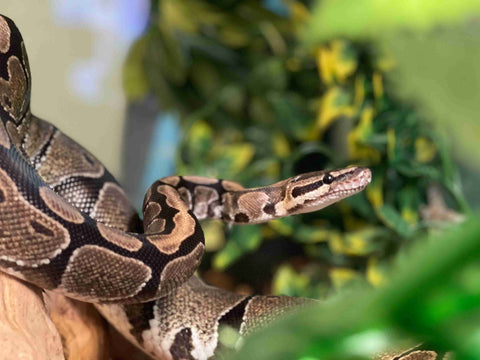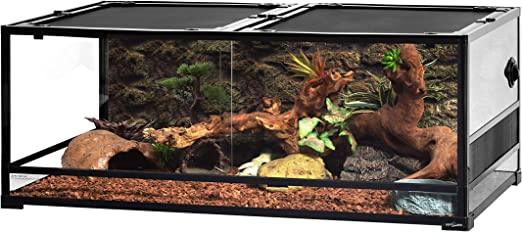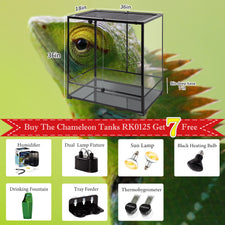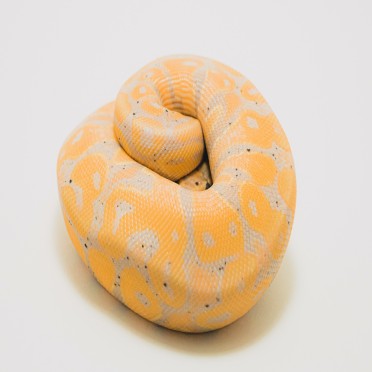People who love animals usually like having a pet. Besides dogs and cats, other pets, too, offer the same warmth and love to their owners when taken care of well.
One such adorable and friendly pet is - the ball python. With their docile yet interesting attributes, they manage to keep their owners engaged.
If you are someone looking to buy or adopt a ball python, this page is just for you. Read on to delve into the salient characteristics and behaviors of ball pythons and the best ways to raise them well.

Your Complete Guide to Bringing Up Your New Reptile Friend - The Ball Python
Before you actually get started with raising a pet, it’s imperative to have good knowledge of their general characteristics and attributes so that you can nurture them well.
By the way, do you know why your pet is known as a “ball” python? Well, unlike most snakes, these creatures tend to curl themselves into a tight ball, which gets them the typical name. Besides being adorable pets, they possess some distinct yet interesting attributes. Let’s understand.
Ball Python - Characteristics and Behaviors
They are non-venomous.
Unlike most snakes, ball pythons are not venomous. This is a key factor that makes them great pets among snakes.
They are nocturnal.
While most reptiles are active during the day, ball pythons are nocturnal. So, you need to feed them during the nighttime.
They are solo creatures.
Ball pythons are solitary by nature. As a result, it's best to keep them away from other animals in a separate enclosure.
They have a good lifespan.
If taken care of, ball pythons can live up to 30 years.
They grow moderately in size.
Most ball pythons grow up to 4 - 5 feet in length but weigh 3-5 pounds only.
They are aggressive when shedding.
While most ball pythons are docile, they may sometimes strike when stressed or ill. This behavior is usually observed during their shedding periods. At this time, the snake’s scales around their eyes become loose, causing difficulty in seeing clearly. So, in such times, make sure you approach them carefully.
Ball Python Care Sheet (Starters)
Ball Python Enclosure Needs
As ball pythons are solitary creatures, you need to arrange separate yet spacious enclosures for them. Young ball pythons require a tank or container with 10-20 gallons capacity. Within a period of 3 years, they grow into adults and require close to 40+ gallons or larger capacity. Ensure that all snake enclosures are well-ventilated, allowing enough light, and are provided with a secure, screened lid that prevents the snake from escaping.

In any case, keep your ball python alone in the enclosure. Never bring them in the company of animals of different species.
Temperature Conditions
Ball pythons thrive well in well-maintained and regulated temperature conditions. That said, it’s essential you keep the temperature within the proper range so that your pet is comfortable. Ideally, you should place two thermometers, one in a warm area and another in a cold area, to ensure the temperatures of both zones are checked at the same time.
The prescribed temperatures for ball pythons are 95 F on the warmer side and 78 F on the cooler end. It’s recommended to provide a thermal gradient in their enclosure so your ball python pet grows well.
Heating and Lighting
Similar to temperature, adequate lighting and heating are also equally important to the healthy growth of ball pythons. You can fit a lamp with a heat bulb over the tank or the enclosure. The bulb’s wattage, in turn, depends on various factors like the size of the container, distance of the bulb from the snake, and the temperature maintained in the enclosure.
Besides over-the-tank heating bulbs, you can also install under-tank heating pads to maintain appropriate temperatures. In addition to light, some bulbs also emit UV light. Make sure you thoroughly check the light sources before installing them. Experts say that daily exposure to UV light is good for ball pythons and helps boost their immune system.
It’s recommended to provide 8-12 hours of UV light every day to give them an equivalent amount of sunlight.
Humidity Requirements
Yet another parameter crucial to the healthy growth and development of ball pythons is humidity conditions. These reptiles require a good amount of humidity to remain hydrated. This, in turn, helps in the development of their respiratory organs and healthy shedding cycles.
It’s recommended to maintain humidity levels between 40% and 60% always. However, during shedding periods, they need additional humidity of around 70%. You may use a hygrometer to measure and keep track of humidity levels in their enclosure.
Other requirements
Climbing Branches
Ball pythons are agile and tend to enjoy climbing and running around branches. So, it’s a great idea to create branches in the enclosure to keep them engaged and get some exercise.
Hiding places
Hideouts must ideally provide two options to ball pythons - one on the warmer and the other on the cooler end. Ensure the humidity requirements are met as required. Ensure that your pet is not always hiding, as they must get exposure to UV light.
Moss
It is a good idea to add some moistened sphagnum moss on the warmer side of the hideout to create some humidity. Moss helps in maintaining moisture levels, which aids in shedding.
Diet and Feeding
Diet is most important for the healthy growth of your pet. Ensure you offer it a rich, balanced, and nutritious diet. Keep the below pointers in mind with regard to your pet’s diet and feeding.
- Best foods include thawed frozen rodents like rats and mice.
- Feed juvenile ball pythons with hairless mice. Once they reach adulthood, you may offer them larger rats.
- Adults must be fed every 1-2 weeks, juveniles must be fed once a week, and baby snakes must be fed every other day.
- Most importantly, always keep in mind that the prey size must be the size of the snake’s mid-section body.
- Place fresh, clean water in large containers as they consume a lot during shedding periods.
Pointers for feeding your ball python
- Never offer them live prey as some rats and mice may get violent, causing wounds resulting in infections to your pet.
- Always ensure you feed them in separate enclosures.
- Always feed at night as they are nocturnal.
- Use feeding tongs to feed rather than with your fingers
Steps to thaw frozen food for your pet
- Take out the frozen items from the bag
- Next, place them in a sealed container and keep them for thawing in a container with cold water.
- Once the food thaws, remove the cold water.
- Now, place the sealed bag in some warm water for 10-15 minutes. Then, discard the warm water.
- Before feeding, use some hot water on the sealed bag to bring the food to room temperature.
- Remove the food from the sealed bag and feed it with tongs.
Diseases, Healthcare, and Grooming Guidelines
It’s recommended to take your pet ball python at least once a year to a vet. You could carry them in a well-ventilated plastic-lidded container. Provide all information, if possible, pictures of the enclosure, feeding patterns, and others to the vet so that they can advise accordingly.
👉 Dive into our:Have A Reptiles Snake? Here’s How You Keep It Healthy!
Common Diseases
Trauma due to infections:
Sometimes, feeding on live prey may result in wounds causing infections. That’s why it is advisable not to feed live rodents.
Anorexia:
Your ball python may stop eating regularly or show signs of reducing weight. Usually, when newly brought home, they refuse food until they get used to it. However, if it goes on for weeks, it could lead to infection.
Dysecdysis:
This refers to problems in shedding when the eye caps or spectacles are retained. Mostly, this issue is caused by environmental conditions such as insufficient humidity or improper temperature conditions.
Skin Infections:
This could result in abnormalities on the ball python’s skin surface. The cause could be a lack of proper grooming, unclean enclosures, etc. Ensure you maintain adequate hygiene in your pet’s enclosure and clean its surroundings.
Dystocia:
Sometimes, in female ball pythons, eggs may get stuck. This is referred to as dystocia. Consult a vet in such situations.
Healthcare: Time to consult a vet?
- Blisters or ulcers on the skin
- Skipping a couple of feeding sessions
- Lethargy
- Seems to be losing weight
- Sudden inability to move a section of their body
Grooming guidelines
In ball pythons, the most important aspect of grooming is with regard to shedding. Ideally, the shedding must happen regularly, and it must shed its skin as a single complete piece. It’s also important that the snake’s eye caps or spectacles also come off with the rest of the skin while shedding. Otherwise, this could lead to health problems in your pet. In case the spectacles don’t come off on their own, consult a vet.
To ensure the shedding process happens smoothly and regularly, keep your pet’s enclosure well-ventilated and maintain humidity levels at 70%. Additionally, place large containers with fresh, clean, and sufficient water. Ball pythons can soak their bodies in the water, which would help them shed. Besides, include moistened sphagnum moss in their hiding places to bring in humidity. In addition, you can mist them to increase humidity and make the shedding easier.
Remember, during shedding, ball pythons are irritable and may not eat for several weeks. However, if they don’t eat for long periods, they become ill. In case your pet skips a couple of feeding sessions while it is not shedding, it’s time to consult a vet.
Wrapping up
Ball pythons are absolutely awesome pets and companions. We hope this care sheet will certainly help beginners in getting started with raising their new reptile pet. Follow the guidelines and give all the care and affection to your adorable pet so that you receive the same in return.









